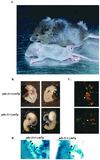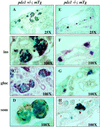PDX:PBX complexes are required for normal proliferation of pancreatic cells during development
- PMID: 11158595
- PMCID: PMC14709
- DOI: 10.1073/pnas.98.3.1065
PDX:PBX complexes are required for normal proliferation of pancreatic cells during development
Abstract
The homeobox factor PDX-1 is a key regulator of pancreatic morphogenesis and glucose homeostasis; targeted disruption of the PDX-1 gene leads to pancreatic agenesis in pdx-1(-/-) homozygotes. Pdx-1 heterozygotes develop normally, but they display glucose intolerance in adulthood. Like certain other homeobox proteins, PDX-1 contains a consensus FPWMK motif that promotes heterodimer formation with the ubiquitous homeodomain protein PBX. To evaluate the importance of PDX-1:PBX complexes in pancreatic morphogenesis and glucose homeostasis, we expressed either wild-type or PBX interaction defective PDX-1 transgenes under control of the PDX-1 promoter. Both wild-type and mutant PDX-1 transgenes corrected glucose intolerance in pdx-1 heterozygotes. The wild-type PDX-1 transgene rescued the development of all pancreatic lineages in pdx-1(-/-) animals, and these mice survived to adulthood. In contrast, pancreata from pdx-1(-/-) mice expressing the mutant PDX-1 transgene were hypoplastic, and these mice died within 3 weeks of birth from pancreatic insufficiency. All pancreatic cell types were observed in pdx-1(-/-) mice expressing the mutant PDX-1 transgene; but the islets were smaller, and increased numbers of islet hormone-positive cells were noted within the ductal epithelium. These results indicate that PDX-1:PBX complexes are dispensable for glucose homeostasis and for differentiation of stem cells into ductal, endocrine, and acinar lineages; but they are essential for expansion of these populations during development.
Figures




Similar articles
-
The pancreatic islet factor STF-1 binds cooperatively with Pbx to a regulatory element in the somatostatin promoter: importance of the FPWMK motif and of the homeodomain.Mol Cell Biol. 1995 Dec;15(12):7091-7. doi: 10.1128/MCB.15.12.7091. Mol Cell Biol. 1995. PMID: 8524276 Free PMC article.
-
Hepatocyte nuclear factor 3beta is involved in pancreatic beta-cell-specific transcription of the pdx-1 gene.Mol Cell Biol. 1997 Oct;17(10):6002-13. doi: 10.1128/MCB.17.10.6002. Mol Cell Biol. 1997. PMID: 9315659 Free PMC article.
-
The homeodomain protein IDX-1 increases after an early burst of proliferation during pancreatic regeneration.Diabetes. 1999 Mar;48(3):507-13. doi: 10.2337/diabetes.48.3.507. Diabetes. 1999. PMID: 10078550
-
Pancreas duodenum homeobox-1 regulates pancreas development during embryogenesis and islet cell function in adulthood.Eur J Endocrinol. 2002 Feb;146(2):129-41. doi: 10.1530/eje.0.1460129. Eur J Endocrinol. 2002. PMID: 11834421 Review.
-
PDX-1 and the pancreas.Pancreas. 2004 Mar;28(2):109-20. doi: 10.1097/00006676-200403000-00001. Pancreas. 2004. PMID: 15028942 Review.
Cited by
-
Specific targeting of pancreatic islet cells in vivo by insulin-promoter-driven adenoviral conjugated reporter genes.World J Surg. 2006 Aug;30(8):1543-52. doi: 10.1007/s00268-005-0688-3. World J Surg. 2006. PMID: 16855800
-
Transcription factor PDX-1 in human colorectal adenocarcinoma: a potential tumor marker?World J Gastroenterol. 2008 Oct 14;14(38):5823-6. doi: 10.3748/wjg.14.5823. World J Gastroenterol. 2008. PMID: 18855980 Free PMC article.
-
Refined localization of the FAT1 quantitative trait locus on pig chromosome 4 by marker-assisted backcrossing.BMC Genet. 2006 Mar 17;7:17. doi: 10.1186/1471-2156-7-17. BMC Genet. 2006. PMID: 16542463 Free PMC article.
-
Overexpression of the Pdx-1 homeodomain transcription factor impairs glucose metabolism in cultured rat hepatocytes.Molecules. 2008 Oct 28;13(10):2659-73. doi: 10.3390/molecules13102659. Molecules. 2008. PMID: 18971862 Free PMC article.
-
A feat of metabolic proportions: Pdx1 orchestrates islet development and function in the maintenance of glucose homeostasis.Mol Genet Metab. 2007 Sep-Oct;92(1-2):43-55. doi: 10.1016/j.ymgme.2007.06.008. Epub 2007 Jul 30. Mol Genet Metab. 2007. PMID: 17659992 Free PMC article. Review.
References
-
- Offield M, Jetton T, Labosky P, Ray M, Stein R, Magnuson M, Hogan B, Wright C. Development (Cambridge, UK) 1996;122:983–995. - PubMed
-
- Jonsson J, Carlsson L, Edlund T, Edlund H. Nature (London) 1994;13:606–609. - PubMed
-
- Stoffers D, Zinkin N, Stanojevic V, Clarke W L, Habener J F. Nat Genet. 1997;15:106–110. - PubMed
-
- Dutta S, Bonner-Wier S, Wright C, Montminy M. Nature (London) 1998;392:560. - PubMed
Publication types
MeSH terms
Substances
Grants and funding
LinkOut - more resources
Full Text Sources
Molecular Biology Databases
Research Materials

